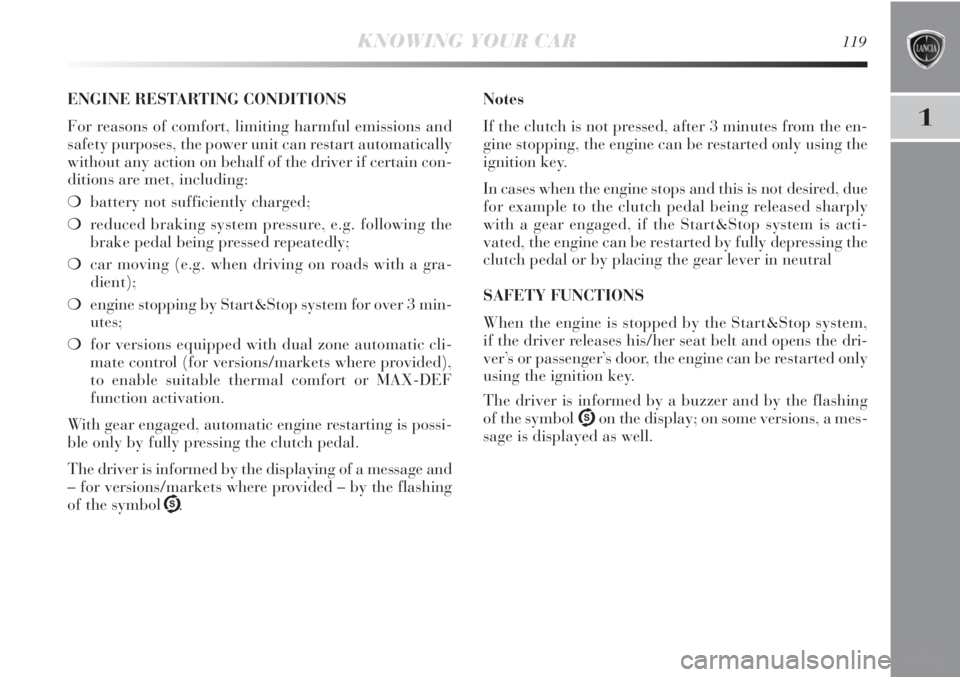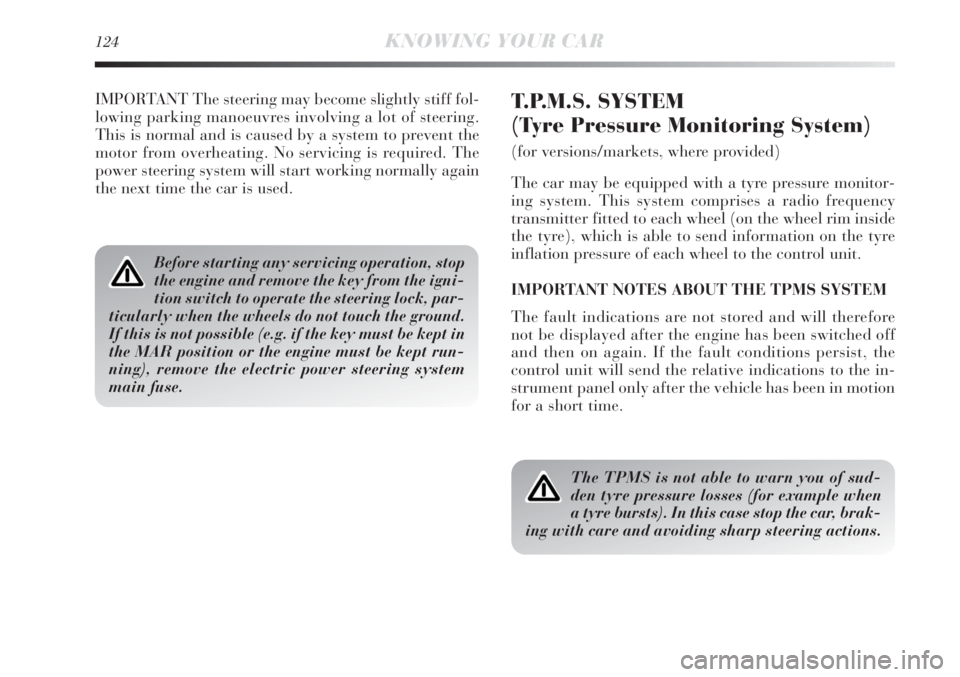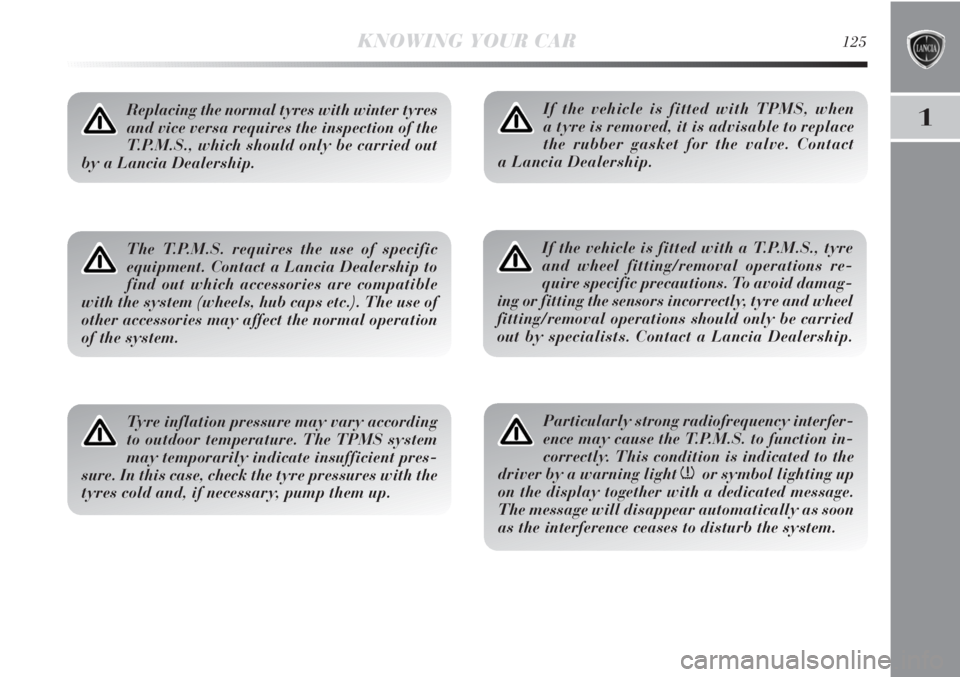display Lancia Delta 2011 Owner handbook (in English)
[x] Cancel search | Manufacturer: LANCIA, Model Year: 2011, Model line: Delta, Model: Lancia Delta 2011Pages: 290, PDF Size: 8.36 MB
Page 120 of 290

1
KNOWING YOUR CAR119
ENGINE RESTARTING CONDITIONS
For reasons of comfort, limiting harmful emissions and
safety purposes, the power unit can restart automatically
without any action on behalf of the driver if certain con-
ditions are met, including:
❍battery not sufficiently charged;
❍reduced braking system pressure, e.g. following the
brake pedal being pressed repeatedly;
❍car moving (e.g. when driving on roads with a gra-
dient);
❍engine stopping by Start&Stop system for over 3 min-
utes;
❍for versions equipped with dual zone automatic cli-
mate control (for versions/markets where provided),
to enable suitable thermal comfort or MAX-DEF
function activation.
With gear engaged, automatic engine restarting is possi-
ble only by fully pressing the clutch pedal.
The driver is informed by the displaying of a message and
– for versions/markets where provided – by the flashing
of the symbol U.Notes
If the clutch is not pressed, after 3 minutes from the en-
gine stopping, the engine can be restarted only using the
ignition key.
In cases when the engine stops and this is not desired, due
for example to the clutch pedal being released sharply
with a gear engaged, if the Start&Stop system is acti-
vated, the engine can be restarted by fully depressing the
clutch pedal or by placing the gear lever in neutral
SAFETY FUNCTIONS
When the engine is stopped by the Start&Stop system,
if the driver releases his/her seat belt and opens the dri-
ver’s or passenger’s door, the engine can be restarted only
using the ignition key.
The driver is informed by a buzzer and by the flashing
of the symbol Uon the display; on some versions, a mes-
sage is displayed as well.
Page 121 of 290

120KNOWING YOUR CAR
ENERGY SAVING FUNCTION
(for versions/markets where provided)
If, as a result of the automatic engine restarting, the dri-
ver does not carry out any action on the vehicle for over
3 minutes, the Start&Stop system stops the engine once
and for all, to prevent fuel consumption. In these cases,
the engine can be restarted only by using the ignition key.
NOTE In any case, it is possible to keep the engine run-
ning by deactivating the Start&Stop system.
OPERATING IRREGULARITIES
In the event of malfunction, the Start&Stop system is de-
activated. The driver is informed about the failure
through the switching-on of the symbol Uon the in-
strument panel and – for some versions – through the
displaying of a message. In this case, go to a Lancia
Dealership.CAR INACTIVITY
In cases of car inactivity, special attention must be paid
due to the disconnection of the battery power supply.
Proceed as follows: detach the connector A-fig. 76 (by
pressing button B) from sensor C for monitoring the sta-
tus of the battery installed on the negative battery pole
D. This sensor should never be disconnected from the
pole except if the battery is replaced.
fig. 76L0E0191m
When replacing the battery, always contact
a Lancia Dealership. Replace the battery
using a new one of the same type (HEAVY
DUTY) and with the same specifications.
Page 123 of 290

122KNOWING YOUR CAR
EOBD SYSTEM
The EOBD system (European On Board Diagnosis) car-
ries out a continuous diagnosis of the components of the
car related to emissions. It also alerts the driver, by turn-
ing on the
Uwarning light in the instrument panel to-
gether with a message in the reconfigurable multifunc-
tion display, when these components are no longer in
peak condition (see “Instrument panel warning lights”
chapter).
The goal of the system is to:
❍to keep system efficiency under control;
❍to signal a fault which causes emission levels to in-
crease;
❍to signal the need to replace deteriorated components.
The system also has a diagnosis connector that can be in-
terfaced to suitable instruments, to read the error codes
stored in the control unit together with a series of specific
parameters for engine operation and diagnosis.
This check can also be carried out by traffic control au-
thorities.
IMPORTANT After eliminating the problem, to check the
system completely, Lancia Dealerships run a bench test
and, if necessary, road tests which may also call for a long
journey.
Go to a Lancia Dealership as soon as pos-
sible if warning light
Ueither does not light
up when the key is turned to MAR–ON or if,
while travelling, the warning light comes on either
steadily or flashing (along with a message in the
reconfigurable multifunction display). The oper-
ation of the warning light
Umay be checked by the
traffic control authorities using specific devices.
Always comply with the traffic regulations in force
in the country where you are driving.
“DUALDRIVE” ELECTRIC POWER
STEERING SYSTEM
THIS is an electrically controlled power steering system
called “Dualdrive”. It is only operational with the igni-
tion key turned to MAR–ON and the engine running; it
can be customised by the driver according to the driving
conditions.
IMPORTANT When turning the ignition key quickly,
complete power steering functionality may be achieved
after 1-2 seconds.
Page 124 of 290

1
KNOWING YOUR CAR123
CITY FUNCTION ACTIVATION/DEACTIVATION
Press button A-fig.79 to activate/deactivate the function.
When the function is active, the CITY warning light on
the instrument panel turns on.
When the CITY function is on, the effort required at
steering wheel is lighter, making parking easier: there-
fore, this function is particularly useful for driving in city
centres.
FAILURE INDICATIONS
Any failure of the electric power steering is indicated by
instrument panel warning light gcoming on together
with a message in the reconfigurable multifunction dis-
play. In the event of electric power steering system fail-
ure, the car can be driven with mechanical steering.
IMPORTANT In some circumstances, factors independent
of the electric power steering could cause the warning light
gon the instrument panel to come on. In this case, stop
the car immediately, switch off the engine for about
20 seconds and then restart the engine. If the gwarn-
ing light remains on, together with the message on the re-
configurable multifunction display, contact a Lancia
Dealership as soon as possible.
fig. 79L0E0057m
Under no circumstances should aftermarket
operations be carried out involving steering
system or steering column modifications
(e.g. installation of anti-theft device). This could
negatively affect performance and safety, invali-
date the warranty, cause serious safety problems
and also result in non-compliance of the car with
type-approval requirements.
On some versions, with the CITY function
activated, the SPORT function is not avail-
able. To activate the SPORT function, deactivate
the CITY function and vice versa, because they are
reciprocally incompatible.
Page 125 of 290

124KNOWING YOUR CAR
IMPORTANT The steering may become slightly stiff fol-
lowing parking manoeuvres involving a lot of steering.
This is normal and is caused by a system to prevent the
motor from overheating. No servicing is required. The
power steering system will start working normally again
the next time the car is used.T.P.M.S. SYSTEM
(Tyre Pressure Monitoring System)
(for versions/markets, where provided)
The car may be equipped with a tyre pressure monitor-
ing system. This system comprises a radio frequency
transmitter fitted to each wheel (on the wheel rim inside
the tyre), which is able to send information on the tyre
inflation pressure of each wheel to the control unit.
IMPORTANT NOTES ABOUT THE TPMS SYSTEM
The fault indications are not stored and will therefore
not be displayed after the engine has been switched off
and then on again. If the fault conditions persist, the
control unit will send the relative indications to the in-
strument panel only after the vehicle has been in motion
for a short time.
Before starting any servicing operation, stop
the engine and remove the key from the igni-
tion switch to operate the steering lock, par-
ticularly when the wheels do not touch the ground.
If this is not possible (e.g. if the key must be kept in
the MAR position or the engine must be kept run-
ning), remove the electric power steering system
main fuse.
The TPMS is not able to warn you of sud-
den tyre pressure losses (for example when
a tyre bursts). In this case stop the car, brak-
ing with care and avoiding sharp steering actions.
Page 126 of 290

1
KNOWING YOUR CAR125
Replacing the normal tyres with winter tyres
and vice versa requires the inspection of the
T.P.M.S., which should only be carried out
by a Lancia Dealership.
The T.P.M.S. requires the use of specific
equipment. Contact a Lancia Dealership to
find out which accessories are compatible
with the system (wheels, hub caps etc.). The use of
other accessories may affect the normal operation
of the system.
Tyre inflation pressure may vary according
to outdoor temperature. The TPMS system
may temporarily indicate insufficient pres-
sure. In this case, check the tyre pressures with the
tyres cold and, if necessary, pump them up.
If the vehicle is fitted with TPMS, when
a tyre is removed, it is advisable to replace
the rubber gasket for the valve. Contact
a Lancia Dealership.
If the vehicle is fitted with a T.P.M.S., tyre
and wheel fitting/removal operations re-
quire specific precautions. To avoid damag-
ing or fitting the sensors incorrectly, tyre and wheel
fitting/removal operations should only be carried
out by specialists. Contact a Lancia Dealership.
Particularly strong radiofrequency interfer-
ence may cause the T.P.M.S. to function in-
correctly. This condition is indicated to the
driver by a warning light
nor symbol lighting up
on the display together with a dedicated message.
The message will disappear automatically as soon
as the interference ceases to disturb the system.
Page 129 of 290

128KNOWING YOUR CAR
FAILURE INDICATIONS
Any faults in the parking sensor system are indicated,
when reverse gear is engaged, by the
èwarning light on
the instrument panel lighting up and a dedicated message
appearing in the multifunction display.
OPERATION WITH TRAILER
Sensor operation is automatically deactivated when the
trailer’s electric cable plug is fitted in the car’s tow hook
socket.
The sensors are automatically reactivated when the
trailer’s cable plug is removed.
For correct operation, sensors must always
be clean from mud, dirt, snow or ice. Be
careful not to scratch or damage the sensors
while cleaning them. Avoid using dry, rough or
hard cloths. The sensors should be washed using
clean water with the addition of car shampoo if
necessary. When using special washing equipment
such as high pressure jets or steam cleaning, clean
the sensors very quickly keeping the jet more than
10 cm away.
GENERAL WARNINGS
❍When parking, watch out for obstacles that may
be above or under the sensors.
❍Sometimes, objects placed close to the car are not de-
tected and could therefore cause damage to the car
or be damaged themselves.
The following conditions may influence the performance
of the parking sensor system:
❍Reduced sensor sensitivity and a reduction in the
parking assistance system performance could be due
to the presence on the surface of the sensor of:
ice, snow, mud, thick paint.
❍The sensor may detect a non-existent obstacle (echo
interference) due to mechanical interferences, for ex-
ample when washing the vehicle, rain (strong wind),
hail.
Page 132 of 290

1
KNOWING YOUR CAR131
SENSORS
While searching for a parking place, the system uses side
sensors (see fig. 81).
These sensors are automatically activated below around
30 km/h; during this stage if the driver has just passed
a space that might be useful for a manoeuvre, the func-
tion can be requested using the special button; at this
point the instructions for carrying out the manoeuvre will
be shown on the display. If the function is not requested
by the driver using the special button, no information will
be displayed on the instrument panel.OPERATION
The assisted parking manoeuvre can only be activated
with the instrument panel on and at speeds below about
30 km/h and is divided into the following stages:
❍Activation: pressing the button fig. 82 activates the
search stage.
❍Search: through side sensors, the system continuously
searches for a free parking space, suitable to the vehicle
dimensions. The driver determines on which side of the
road they intend to park using the direction indicators (if
no information is available from the direction indicators
or hazard warning lights, the search takes place on the
passenger side).
IMPORTANT The SEARCH stage in the system logic is
deactivated after about 10 mins if a suitable parking
space is not identified.
fig. 81L0E0240mfig. 82L0E0241m
Page 135 of 290

134KNOWING YOUR CAR
❍parking space longer than 130 cm compared to the
vehicle dimensions:parking in more than one manoeu-
vre, where only the first one can be carried out by auto-
matic steering management (the subsequent manoeuvres
are entirely the responsibility of the driver).
To select the search and manoeuvring side, the driver
must:
1)
DChoose to carry out the search for the space and the
manoeuvre on the passenger side with:
❍the direction indicator in the middle position;
❍the hazard warning lights on;
❍the hazard warning lights on and the direction indi-
cator in the passenger side position;
❍the direction indicator pointing towards the passen-
ger side.
2)
FChoose to carry out the search for the space and the
manoeuvre on the driver’s side with:
❍the direction indicator in the driver’s side position;
❍the hazard warning lights on and the direction indi-
cator in the driver side position;
The system will notify the driver, on the side in which the
search and the manoeuvre are taking place by means of
dedicated messages in the instrument panel display and
the symbol (
Fand
D) different on the right and left sides. The search will, however, take place on both sides, there-
fore it is possible to make the selection using the direc-
tion indicators even when having just driven past a park-
ing space that is deemed suitable.
During the search step, speed should not exceed 30 km/h;
when 25 km/h have been reached, the driver is asked to
decrease the speed; if the speed of 30 km/h is exceeded,
the system is disabled; in this case, the system must be
restarted by pressing the button A-fig. 82.
If the Lane crossing function is activated (see “Exterior
lights” paragraph) the search for the parking space al-
ways takes place on the passenger side.
If the parking sensors are activated during the search for
a parking space (see “Front and rear parking sensors”
paragraph), the operation of the Magic Parking system is
deactivated.
The search for the parking space and the
parking manoeuvres must be made in com-
pliance with the regulations in force of the
Highway Code.
Page 137 of 290

136KNOWING YOUR CAR
If the driver carries out a voluntary or involuntary action
on the steering during the parking manoeuvre (touch-
ing it or preventing its movement), the manoeuvre will
be interrupted.
If the road surface is very uneven or there are obstacles
under the wheels affecting the movement of the vehicle,
preventing it from continuing along the correct trajectory,
the manoeuvre may be interrupted.
Manoeuvre end
If the size of parking space permits, the parking ma-
noeuvre may be performed in one go; when reverse gear
is released the wheels will be realigned and the manoeu-
vre will be considered completed; the system will conse-
quently be deactivated. If the size of the parking space is
smaller, it may take several manoeuvres, the driver will
be advised to complete the parking manoeuvre manually
via a dedicated messages in the instrument panel display.General warnings
❍The ultimate responsibility when parking, however,
always rests with the driver. During these manoeuvres,
always make sure that no people, animals or objects are
within the manoeuvring area. The Magic Parking sys-
tem (like parking sensors) is designed to assist drivers: in
all cases, you must always pay the utmost attention dur-
ing potentially dangerous manoeuvres, even when these
are carried out a low speed:
❍If the sensors undergo shocks influencing their posi-
tion, the system operation could be strongly degraded.
❍If the sensors are dirty, covered by snow, ice or mud
or are repainted compared to the original conditions, the
system operation could be strongly degraded.
❍It is extremely important, for the correct operation of
the system, that the sensors are always kept clean. Dur-
ing cleaning make sure not to scratch or damage them;
avoid using dry or rough cloths. The sensors should be
washed using clean water with the addition of car sham-
poo if necessary. When using special washing equipment
such as high pressure jets or steam cleaning, clean the
sensors very quickly keeping the jet more than 10 cm
away.
If you wish to stop the steering wheel with
your hands during a manoeuvre, it is
advisable to handle it firmly on the outer
rim. Do not try and keep your hands on the inside
or hold the spokes.